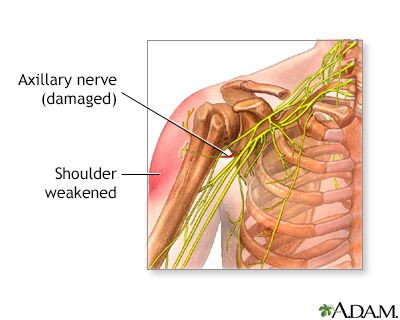Pregnancy SmartSiteTM
Neuropathy - axillary nerve DefinitionAxillary nerve dysfunction is nerve damage that can lead to a loss of movement or sensation in the shoulder. CausesAxillary nerve dysfunction is a form of peripheral neuropathy. It occurs when there is damage to the axillary nerve. This is the nerve that helps control the deltoid muscles of the shoulder and the skin around it. A problem with just one nerve, such as the axillary nerve, is called mononeuropathy. The usual causes are:
Entrapment creates pressure on the nerve where it passes through a narrow structure. The damage can destroy the myelin sheath that covers the nerve or part of the nerve cell (the axon). Damage of either type reduces or prevents the movement of signals through the nerve. Conditions that can lead to axillary nerve dysfunction include:
In some cases, no cause can be found. SymptomsSymptoms may include any of the following:
Exams and TestsYour health care provider will examine your neck, arm, and shoulder. Weakness of the shoulder can cause difficulty moving your arm. The deltoid muscle of the shoulder may show signs of muscle atrophy (loss of muscle tissue and thinning). Tests that may be used to check axillary nerve dysfunction include:
TreatmentDepending on the cause of the nerve disorder, some people do not need treatment. The problem may get better on its own. The rate of recovery is different for everyone. It can take many months to recover. Anti-inflammatory medicines may be given if you have any of the following:
These medicines reduce swelling and pressure on the nerve. They may be injected directly into the area or taken by mouth. Other medicines include:
If your symptoms continue or get worse, you may need surgery. If a trapped nerve is causing your symptoms, surgery to release the nerve may help you feel better. Physical therapy can help maintain muscle strength. Job changes, muscle retraining, or other forms of therapy may be recommended. Outlook (Prognosis)It may be possible to make a full recovery if the cause of the axillary nerve dysfunction can be identified and successfully treated. Possible ComplicationsComplications may include:
When to Contact a Medical ProfessionalContact your provider for an appointment if you have symptoms of axillary nerve dysfunction. Early diagnosis and treatment increase the chance of controlling symptoms. PreventionPreventive measures vary, depending on the cause. Avoid putting pressure on the underarm area for long periods. Make sure casts, splints, and other appliances fit properly. When you use crutches, learn how to avoid putting pressure on the underarm. ReferencesChad DA, Bowley MP. Disorders of nerve roots and plexuses. In: Jankovic J, Mazziotta JC, Pomeroy SL, Newman NJ, eds. Bradley and Daroff's Neurology in Clinical Practice. 8th ed. Philadelphia, PA: Elsevier; 2022:chap:105. Hess DE, Taylor KF, Chhabra AB. Nerve entrapment. In: Miller MD, Thompson SR, eds. DeLee, Drez, & Miller's Orthopaedic Sports Medicine. 5th ed. Philadelphia, PA: Elsevier; 2020:chap 54. Pierrie SN, Loeffler BJ. Common nerve injuries about the shoulder. In: Skirven TM, Osterman AL, Fedroczyk JM, Amadio PC, Feldscher SB, Shin EK, eds. Rehabilitation of the Hand and Upper Extremity. 7th ed. Philadelphia, PA: Elsevier; 2021:chap 47. | ||
| ||
Review Date: 2/11/2025 Reviewed By: Joseph V. Campellone, MD, Department of Neurology, Cooper Medical School at Rowan University, Camden, NJ. Review provided by VeriMed Healthcare Network. Also reviewed by David C. Dugdale, MD, Medical Director, Brenda Conaway, Editorial Director, and the A.D.A.M. Editorial team. View References The information provided herein should not be used during any medical emergency or for the diagnosis or treatment of any medical condition. A licensed medical professional should be consulted for diagnosis and treatment of any and all medical conditions. Links to other sites are provided for information only -- they do not constitute endorsements of those other sites. No warranty of any kind, either expressed or implied, is made as to the accuracy, reliability, timeliness, or correctness of any translations made by a third-party service of the information provided herein into any other language. © 1997- A.D.A.M., a business unit of Ebix, Inc. Any duplication or distribution of the information contained herein is strictly prohibited. | ||


 Damaged axillary n...
Damaged axillary n...
